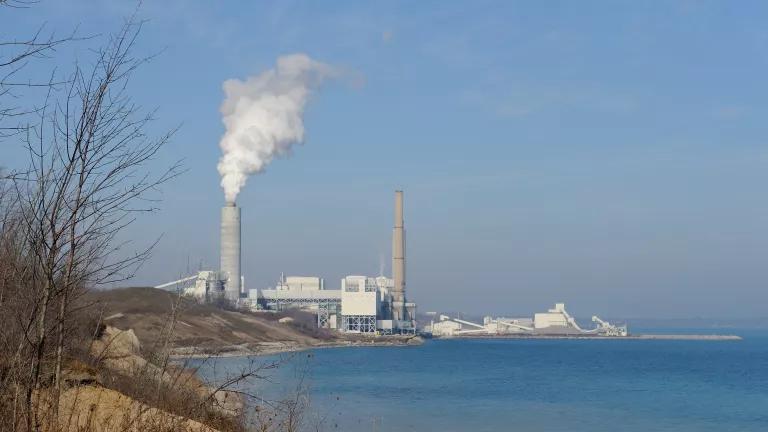China’s Climate Progress Ahead of COP27
China’s efforts to shift to a new energy system and meet its 2030 climate goals can boost both energy security and climate security.

An electric vehicle (EV) bus in Beijing. The city of Beijing is planning for all buses, taxis, sanitation vehicles and other public vehicles to be electric by 2025.
2022 will be remembered as the year that the real-world impacts of climate change became clear around the world, through unrelenting heatwaves, droughts and wildfires, and record-breaking storms and flooding. China was no exception, having weathered a drought and severe heat wave that was the most severe in six decades, lasting over 70 days and affecting 900 million people in at least 17 provinces with temperatures over 40 Celsius (104 Fahrenheit).
As a result of the drought, hydropower reservoir levels along the Yangtze River were half their normal levels, leading to a power shortage just as power demand caused by the heatwave was peaking due to increased air conditioning demand.
With the impacts of climate change becoming clearer, China continued to push forward efforts to meet its 2030 climate goals under the Paris Agreement. Here’s where China stands going into COP27 in terms of these goals:
- Peaking CO2 emissions before 2030: China’s CO2 emissions are estimated by the International Energy Agency to have reached 11.9 billion tons in 2021, an increase of 750 million tons compared to 2019 as its economy rebounded strongly in 2021.
However, recent analysis has estimated that emissions have fallen since mid-2021 to the second quarter of 2022, due to an economic slowdown as well as strong growth in renewables. While it depends on the future direction of China’s economy, it is likely that many of its most coal and carbon-intensive sectors have already or will soon peak. NRDC-supported research on 4 key sectors – power, iron and steel, cement and coal chemicals – which together comprised 86% of domestic coal consumption and 72% of China’s carbon emissions in 2019 – found that the combined coal consumption and carbon emissions from these 4 sectors could peak by 2025.
- Cutting its carbon intensity (CO2 emissions per share of GDP) by more than 65% by 2030 from 2005 levels: China’s carbon intensity in 2021 fell by 50.8% compared to 2005 levels.
- Increasing the share of non-fossil energy (renewables and nuclear energy) in primary energy consumption to 25%: As of 2021, non-fossil energy had increased to 16.6% of primary energy consumption.
Much of this growth has come from continued rapid growth in wind and solar, as well as huge growth in the share of new energy vehicles; in September, battery electric vehicles accounted for 26% of new car sales. Overall, China continues to lead the world in clean energy investment, reaching $266 billion in low carbon investment in 2021, especially renewable energy and new energy vehicles.
- Increasing forest stock by 6 billion cubic meters from 2005: China’s forest stock volume reached 19.4 billion cubic meters by 2021, which exceeds the goal the country set for 2025, and the country also announced in May a new goal to plant, conserve, restore and manage 70 billion trees by 2030.
- Increasing combined wind and solar power capacity to 1,200GW: Based on a compilation of the latest provincial 14th FYP renewables targets, 30 provinces plan to add a total 874 GW of wind and solar in the 14th Five Year Plan period (2021-25). Given China's wind and solar capacity at the end of the 13th Five Year Plan (2020) was already 535 GW, this would mean that China could achieve and exceed its goal to build 1,200 GW of wind and solar by around 2025, 5 years early.
China’s efforts to achieve its climate goals, however, are facing some of the same challenges faced by other countries, particularly given prioritization of energy security amid a period of uncertainty. In the short term, that has meant the government has focused on boosting coal production to ensure adequate supply, setting a goal to increase coal production to 4.6 billion tons by 2025, compared to 4.1 billion tons in 2021. This is in line with President Xi’s statement that “China will advance initiatives to reach peak carbon emissions in a well-planned and phased way in line with the principle of building the new before discarding the old.”
That said, the greater emphasis on coal due to energy security concerns in the short-term should not overshadow China’s ongoing efforts to decarbonize its economy and reduce its emissions in the medium and long-term; doing so is in its own interests in order to combat the worsening impacts of climate change which were highlighted this past summer. To do so, China will need to accelerate its efforts to build a new energy system based on new energy, which is flexible and smart to accommodate greater shares of variable wind and solar. Accelerating this shift to the new energy system will help China to ensure that it can peak its fossil fuel use and carbon emissions as early and as low as possible, strengthening both its future energy security and climate security.



